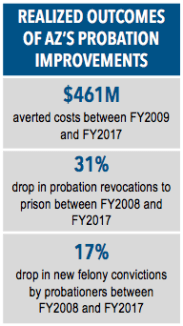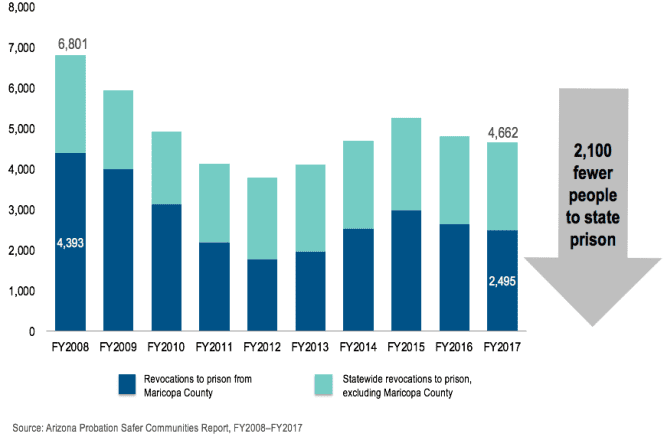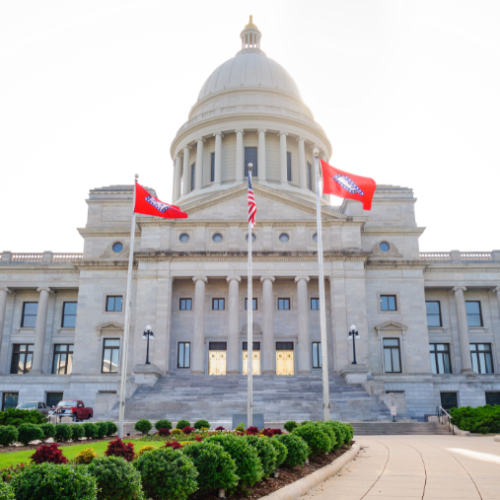Probation Performance: How Arizona’s County Probation Departments Increased Public Safety While Saving Taxpayers Millions
[UPDATED: August 7, 2018]
When the Arizona legislature pursued justice reinvestment in 2007, the state’s probation system was in need of repair. In 2008, people who violated the conditions of their probation accounted for one-third of all prison admissions and received, on average, a two-year sentence to prison for failing on probation. As a result, the state spent an estimated $100 million to send more than 4,000 people to prison annually for violating the conditions of their supervision. Since then, Arizona has implemented a series of policies that have helped the state reduce the number of probationers revoked to prison for violating supervision conditions and committing new crimes, and ultimately saved taxpayers more than $461 million between FY2009 and FY2017.
 Strengthening Probation
Strengthening Probation
In response to those challenges, Arizona’s legislature enacted the Safe Communities Act of 2008, which created incentives for people to succeed on probation and goals for agencies to reduce the number of new crimes and technical violations committed by people on probation. The law also required the Supreme Court’s Administrative Office of the Courts (AOC) to annually report to the legislature each agency’s progress toward meeting those goals.
Since then, the AOC and chief probation officers across the state have doubled down on efforts to improve probation that had been underway for more than a decade.
The State Supreme Court developed, and Arizona’s Superior Court probation departments adopted, a series of statewide policy changes, training initiatives, and hiring improvements to make the state’s probation system more effective at ensuring public safety while saving taxpayer dollars.
- Policy changes included requiring judges to receive presentence reports that include criminogenic risk and needs assessment results, and updating supervision standards for determining how people of all risk levels are supervised.
- Training initiatives targeted toward probation officers, judges, and other criminal justice stakeholders included adopting evidence-based practices (EBPs), using presentence reports to inform supervision conditions, and focusing time and resources on people most likely to reoffend.
- Hiring practices were updated as Arizona moved from a compliance-oriented approach to monitoring and reacting to violations to focusing on probationer accountability and behavior change. New recruits now receive training on EBPs as the first class at the academy, and all officers receive ongoing training annually.
Seeing Results
These policy changes, which included the performance goals set by the Safe Communities legislation, and training efforts are paying off.
- Between FY2008 and FY2017, the number of probationers revoked to prison fell 31 percent.
- During that period, the number of new felony convictions fell 17 percent.
- Between 2008 and 2016, Arizona’s crime rate fell 27 percent, and the state went from having the 4th highest crime rate in the country to the 9th highest.
- Despite concerns that state policy changes may negatively impact jails by causing revocations to jail instead of prison, between FY2008 and FY2017, probation revocations to jail fell in 10 of 15 counties.
Between FY2008 and FY2017, all but three of Arizona’s counties saw probation revocations to prison decline. Maricopa County, home to two-thirds of probationers in the state, has been a driving force in reducing revocations to prison. When revocations to prison fell by 2,139 statewide between FY2008 and FY2017, Maricopa County was responsible for the vast majority of that drop (1,898 revocations). [See Figure 1]

“We are currently working to expand our capacity to provide cognitive behavioral programming designed to reduce the risk of reoffense, increase our efforts to integrate the health care and justice systems by providing health care literacy classes and opportunities to enroll in health care, and hire and retain a quality and diverse workforce,” said Barbara Broderick, Chief Probation Officer of the Maricopa County Adult Probation Department. “We believe all of these efforts will have a positive impact and further reduce probation revocations.”
The drop in probation revocations is also impacting the state’s prison population. After decades of growth, the state’s prison population leveled off between 2009 and 2012 due to fewer probationers entering prison. [See Figure 2]

Looking Ahead
Arizona’s county probation departments may need additional funding to provide appropriate levels of treatment and other supervision resources that can have as significant an impact as has occurred in Maricopa County. Although the Safe Communities Act included a detailed reinvestment formula requiring the state to share 40 percent of its savings beginning in FY2011 with probation departments that reduced revocations, the state legislature did not follow through due to budget pressures and repealed the requirement to reinvest in 2011. Based on the established formula, almost $112 million would have been reinvested in the probation departments for improvements to supervision. Reinstating this novel performance-based funding opportunity or adding funding to future budgets could help county probation departments continue to implement effective supervision practices and reduce revocations to prison.
“Arizona is safer today than it was 10 years ago because of the changes we’ve made to probation,” said Kathy Waters, Director of Adult Probation Services for AOC. “As probation departments have adopted EBPs, the number of probation revocations and new felony convictions has fallen, which has saved taxpayers more than $460 million. Reinvesting a fraction of those savings in probation services could go a long way toward enhancing the safety of our communities.”
Arkansas policymakers have long expressed concerns about the state’s high recidivism rate. Over the past 10 years, an…
Read MoreIn April 2025, Arkansas Governor Sarah Huckabee Sanders signed a package of bipartisan criminal justice legislation into law,…
Read More Explainer: Key Findings and Options from Arkansas’s Justice Reinvestment Initiative
Explainer: Key Findings and Options from Arkansas’s Justice Reinvestment Initiative
Arkansas policymakers have long expressed concerns about the state’s high recidivism rate.…
Read More Explainer: How a New Law in Arkansas Tackles Crime, Recidivism, and Community Supervision Challenges
Explainer: How a New Law in Arkansas Tackles Crime, Recidivism, and Community Supervision Challenges
In April 2025, Arkansas Governor Sarah Huckabee Sanders signed a package of…
Read More









